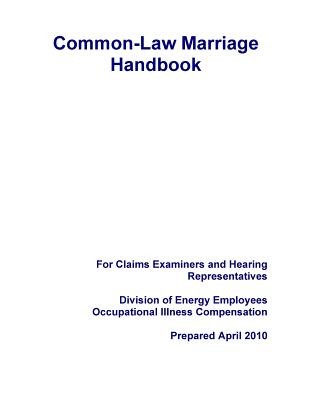
- We will send in 10–14 business days.
- Author: U S Department of Labor
- Publisher: CreateSpace Independent Publishing Platform
- Year: 2014
- Pages: 52
- ISBN-10: 1500500585
- ISBN-13: 9781500500580
- Format: 21.6 x 28 x 0.3 cm, minkšti viršeliai
- Language: English
- SAVE -10% with code: EXTRA
Reviews
Description
This handbook is intended to assist claims examiners in the identification and development of survivor claims that involve potential common-law marriages (these are informal relationships that can sometimes be legally recognized as valid marriages) filed under the Energy Employees Occupational Illness Compensation Program Act of 2000 (EEOICPA). EEOICPA provides that when a covered employee is deceased at the time benefits are to be paid, payment is to be made to the employee's eligible survivors. Thus, in order for a survivor to be entitled to EEOICPA benefits, he/she must provide evidence proving their relationship to the employee.Claimants can assert entitlement to EEOICPA benefits as the employee's surviving spouse by virtue of a common-law marriage. The issue of the existence of a common-law marriage most often arises when a claimant asserts eligibility for survivor benefits due to his/her status as the employee's surviving spouse, but where no licensed marriage ceremony took place. The second most common occurrence is where the claimant and the employee were legally married less than one year prior to the employee's death, but the claimant asserts that they entered into a common-law marriage before the legal marriage that satisfied EEOICPA's one-year marriage requirement. Another variant of the common-law marriage situation exists where the claimant asserts that he/she and the deceased employee were once legally married, then dissolved their marriage, and then reunited to establish a common-law marriage prior to the employee's death.
- Author: U S Department of Labor
- Publisher: CreateSpace Independent Publishing Platform
- Year: 2014
- Pages: 52
- ISBN-10: 1500500585
- ISBN-13: 9781500500580
- Format: 21.6 x 28 x 0.3 cm, minkšti viršeliai
- Language: English English
This handbook is intended to assist claims examiners in the identification and development of survivor claims that involve potential common-law marriages (these are informal relationships that can sometimes be legally recognized as valid marriages) filed under the Energy Employees Occupational Illness Compensation Program Act of 2000 (EEOICPA). EEOICPA provides that when a covered employee is deceased at the time benefits are to be paid, payment is to be made to the employee's eligible survivors. Thus, in order for a survivor to be entitled to EEOICPA benefits, he/she must provide evidence proving their relationship to the employee.Claimants can assert entitlement to EEOICPA benefits as the employee's surviving spouse by virtue of a common-law marriage. The issue of the existence of a common-law marriage most often arises when a claimant asserts eligibility for survivor benefits due to his/her status as the employee's surviving spouse, but where no licensed marriage ceremony took place. The second most common occurrence is where the claimant and the employee were legally married less than one year prior to the employee's death, but the claimant asserts that they entered into a common-law marriage before the legal marriage that satisfied EEOICPA's one-year marriage requirement. Another variant of the common-law marriage situation exists where the claimant asserts that he/she and the deceased employee were once legally married, then dissolved their marriage, and then reunited to establish a common-law marriage prior to the employee's death.


Reviews